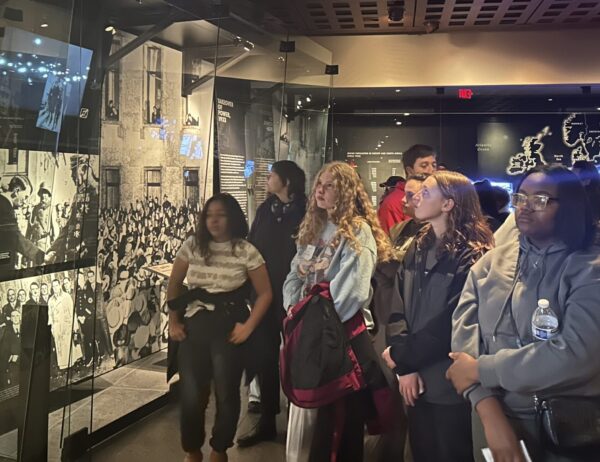
Jewish businesses vandalized, Jewish students attacked at school, cries of “gas the Jews and rid the world of them” are ringing through the streets.
This is today, in 2023, in the United States.
This is 85 years after Kristallnacht, the Night of Broken Glass, and an ocean away from where Nazi leaders unleashed a series of pogroms against the Jews of Germany.
On that evening, at least 96 Jews were killed and hundreds more injured. More than 1,300 synagogues were burned, 7,500 Jewish businesses were destroyed, and more than 35,000 Jews arrested and sent to concentration camps. It has long been said that Kristallnacht was either the end of the beginning of the Holocaust or the beginning of the end of it. Regardless of which way it is viewed, the atrocities of November 9-10, 1938, were in fact only a glimmer of what was to come for the Jews of Europe under the Nazi regime. The horrors of the Holocaust were immeasurable and, at the time, unfathomable.
You might have visited the United States Holocaust Museum in Washington, D.C., and come across the Tower of Faces – a three-floor-high exhibit of pictures of the Jewish community of Eisiskes, a town in Lithuania. These pictures tell the story of the generations of Jewish life in this small town of about 4,500 Jews. What you might not have known was that the entire population of Eisikes was rounded up, starved, and then murdered in a mass shooting between September 25 and 26, 1941. Over 900 years of Jewish life in Eisiskes was gone in less than 48 hours. Only about 20 Jews from the town escaped the slaughter, one young woman by pretending to be dead and hiding under bodies of others.
You might have heard of the story of Ilan Ramon, the Israeli astronaut who sadly lost his life when the space shuttle Columbia exploded upon reentering the atmosphere in 2003. What you might not have heard was that, on that ill-fated mission, Ramon was carrying a tiny Torah scroll from which young boys, alone in Bergen-Belsen concentration camp, were taught to read Torah for their bar mitzvahs. There were so many young Jewish boys in hiding in ghettos and camps that could not have bar mitzvahs, and many of the few that were able to did so alone, without their families.
You might know about the defiance of the Jewish partisan group, the Bielski Brothers, who bravely saved 1,200 Jews in the forests of Belarus. What you might not know is that they fled to the forest after the brutal murder of their parents and siblings at the hands of the Nazis. Most of the Jewish families in the Bielskis’ village and surrounding villages were not rounded up and taken to camps but rather raped, shot, and burned to death within their own homes and towns. After witnessing the horrific atrocities that they did, it was through incredible strength that the Bielskis prevailed.
Since the gruesome attacks by Hamas terrorists on October 7, we continue to learn of stories that seem all too familiar and have shaken Holocaust survivors, their descendants, and the entire Jewish community worldwide.
The story of a survivor of the Supernova Music Festival, during which more than 260 young people were murdered, tells of pretending to be dead in a pile of dead bodies. Just like the girl in Eisiskes, Lithunia.
Or the story of a young boy, just 13, who went out for a run moments before his entire family was murdered. He will now celebrate his bar mitzvah without his parents and siblings, as the only one of his immediate family to survive; just like the boys who celebrated alone in Bergen-Belson.
Or the population of Kibbutz Nir Oz, which was 450 on October 7, 2023, and 190 on October 8. Yet those that remain are moving forward to continue to survive and fight on, just as the Bielskis did.
The demonstrations, hate speech, and vandalism that have followed October 7 around the world – from college campuses to the streets of London, New York, and Sydney to Jew hunting mobs in a Russian airport – painfully evoke memories of Kristallnacht and the Nazis.
Imagine how horrific this is for the several thousand Holocaust survivors who are still alive today.
For the past several decades of Holocaust education, our mantra has been “Never Again.” Then, with the rise of antisemitism over the past few years, we’ve been saying “Never Again Is Now.”
What are we to say now, after what we’ve seen and the world’s reaction to it? It’s not “Never Again,” it’s “Again.” The same seeds of a warning after Kristallnacht, are here, and it’s happening in front of the eyes of Holocaust survivors. How sad it is that they are alive to greet another generation of Jewish survivors of massacres.
As the 85th anniversary of Kristallnacht approaches, we need remember, speak out and educate, for both of these generations of survivors. We now need to ensure that “Again” becomes “Never” once more.
Please join us for a meaningful commemoration of both Veterans Day and Kristallnacht on Thursday, November 9, as we honor Kristallnacht survivor and World War II hero Peter Hirschmann. And then, on Tuesday, December 5, join us at Sharing Our Voices: Keeping the Memories Alive, a luncheon honoring Holocaust survivors and their descendants where we will debut state-of-the-art interactive videos featuring two of our local Holocaust survivors.
Pictured above is a group of students from Montclair High School visiting the United States Holocaust Museum in Washington, D.C. with our Holocaust Council on November 8.

